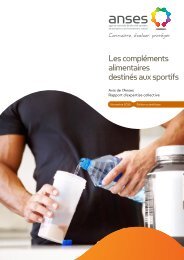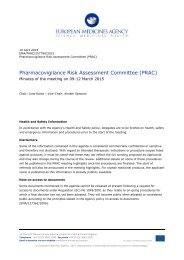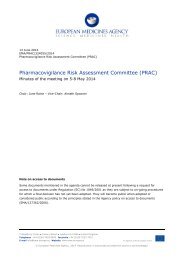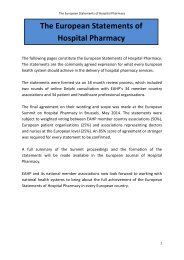WC500165698
WC500165698
WC500165698
You also want an ePaper? Increase the reach of your titles
YUMPU automatically turns print PDFs into web optimized ePapers that Google loves.
Discussion<br />
The PRAC discussed the evidence on the risks of next-morning impaired driving ability and<br />
somnambulism in the context of the use of zolpidem for the short-term treatment of insomnia. It was<br />
agreed that to mitigate these risks the product information of zolpidem containing medicines should be<br />
updated, to include strengthened warnings and precautions and enhanced information on interactions<br />
with other medicinal products that can increase these risks. It was also recommended that there<br />
should be a rest period of at least 8 hours after zolpidem administration before performing activities<br />
that require mental alertness such as driving. The PRAC considered that the recommended daily dose<br />
should remain at 10 mg of zolpidem, and that this dose must not be exceeded; zolpidem should be<br />
taken as a single intake immediately at bedtime without being re-administered during the same night.<br />
The PRAC agreed that the available efficacy data did not provide robust evidence that a lower dose was<br />
effective on a population level. However, it also considered that there were some data indicating that<br />
in some individual patients a lower dose could be effective and therefore patients should take the<br />
lowest effective dose. This information should also be reflected in the product information. In elderly<br />
patients and in patients with reduced liver function, the recommended dose remains 5 mg of zolpidem<br />
per day.<br />
Summary of recommendation(s)/conclusions<br />
The PRAC adopted, by majority, the variation of the marketing authorisations for zolpidem-containing<br />
medicines and adopted a recommendation to be considered by CMDh—see communication ‘PRAC<br />
recommends product information of zolpidem be updated with new advice to minimise the risk of nextmorning<br />
impaired driving ability and mental alertness’ EMA/129598/2014.<br />
Thirty members, voted in favour of the variation together with Iceland and Norway, while one member<br />
had a divergent view 2 .<br />
3.4. Re-examination procedures<br />
3.4.1. Diacerein (NAP)<br />
<br />
Re-examination procedure of the PRAC recommendation following the review of the benefit-risk<br />
balance following notification by France of a referral under Article 31 of Directive 2001/83/EC<br />
based on pharmacovigilance data<br />
Regulatory details:<br />
PRAC Rapporteur: Margarida Guimarães (PT)<br />
PRAC Co-Rapporteur: Harald Herkner (AT)<br />
Administrative details:<br />
Procedure number: EMEA/H/A-31/1349<br />
EPITT 15994 – Follow-up December 2013<br />
MAH(s): Negma-Wockhardt, TRB Chemedica<br />
Oral Explanation(s): Negma-Wockhardt, TRB Chemedica<br />
Background<br />
Following a request for a re-examination of the PRAC recommendation on diacerein-containing<br />
medicines, provided under Article 31 of Directive 2001/83/EC ,and submission of grounds for this re-<br />
2 The relevant AR containing the divergent views will be published on the EMA website once the procedure is fully<br />
concluded.<br />
Pharmacovigilance Risk Assessment Committee (PRAC)<br />
EMA/PRAC/253432/2014 Page 13/64








